Tesco HRM: Value Creation, Cultural Impact and Employment Models
VerifiedAdded on 2023/01/06
|15
|3981
|61
Report
AI Summary
This report offers a comprehensive analysis of human resource management (HRM) practices at Tesco Plc, a multinational retail giant. It begins by exploring how strategic HRM creates value within the organization, emphasizing the importance of aligning HR strategies with business goals. The report then delves into the impact of regional and national cultures on HRM, utilizing Hofstede's cultural model to understand how cultural dimensions influence HR practices like recruitment, training, and compensation. It examines Tesco's hierarchical organizational structure and the key organizational levers used to generate value. A detailed comparison between HRM and personnel management is provided, highlighting their differences in approach and focus. The report also discusses the significance of local culture in HRM, the employment laws applicable when international HRM changes local business systems and offers corporate examples and literature. Finally, the report concludes with recommendations for employers regarding effective HRM practices and strategies to enhance organizational performance and employee satisfaction.
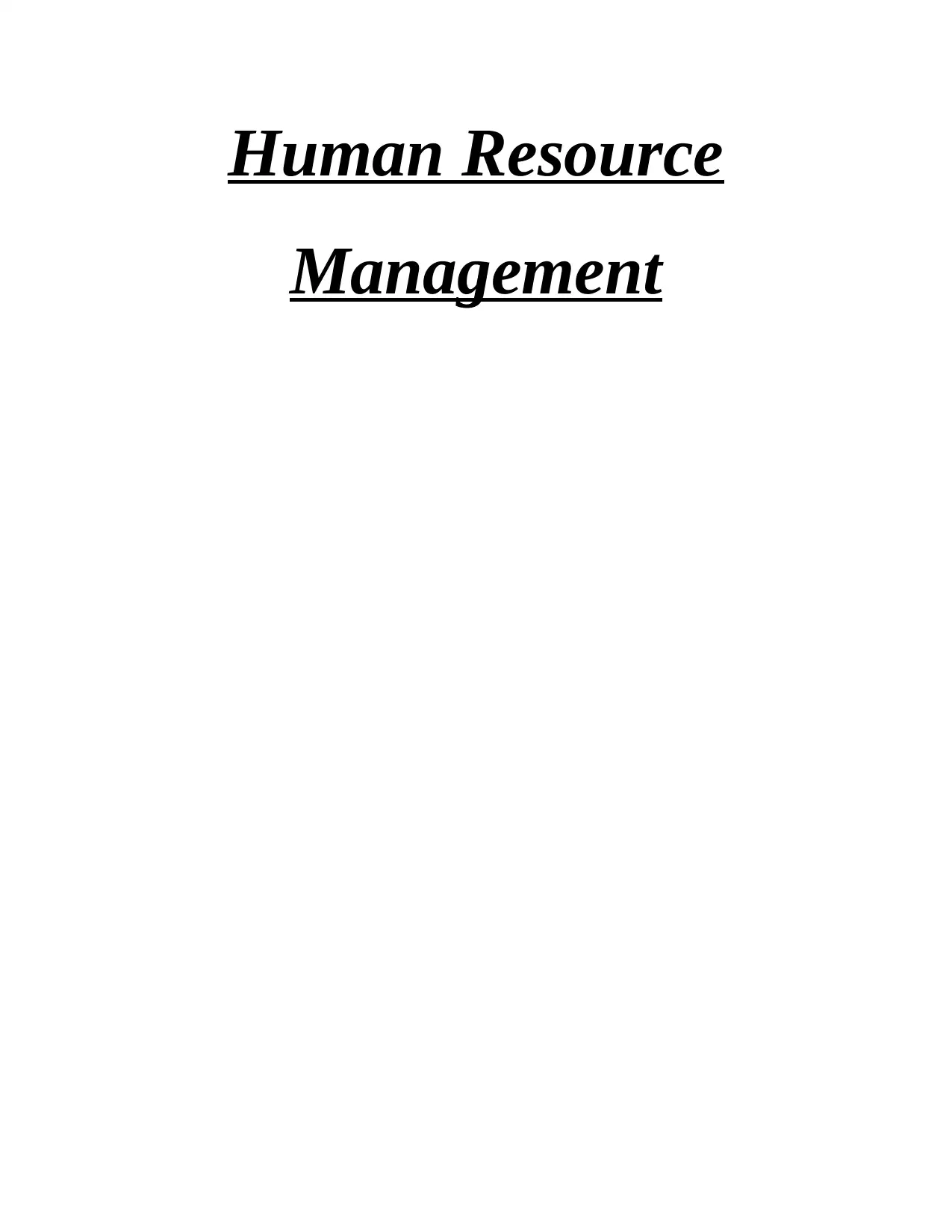
Human Resource
Management
Management
Paraphrase This Document
Need a fresh take? Get an instant paraphrase of this document with our AI Paraphraser

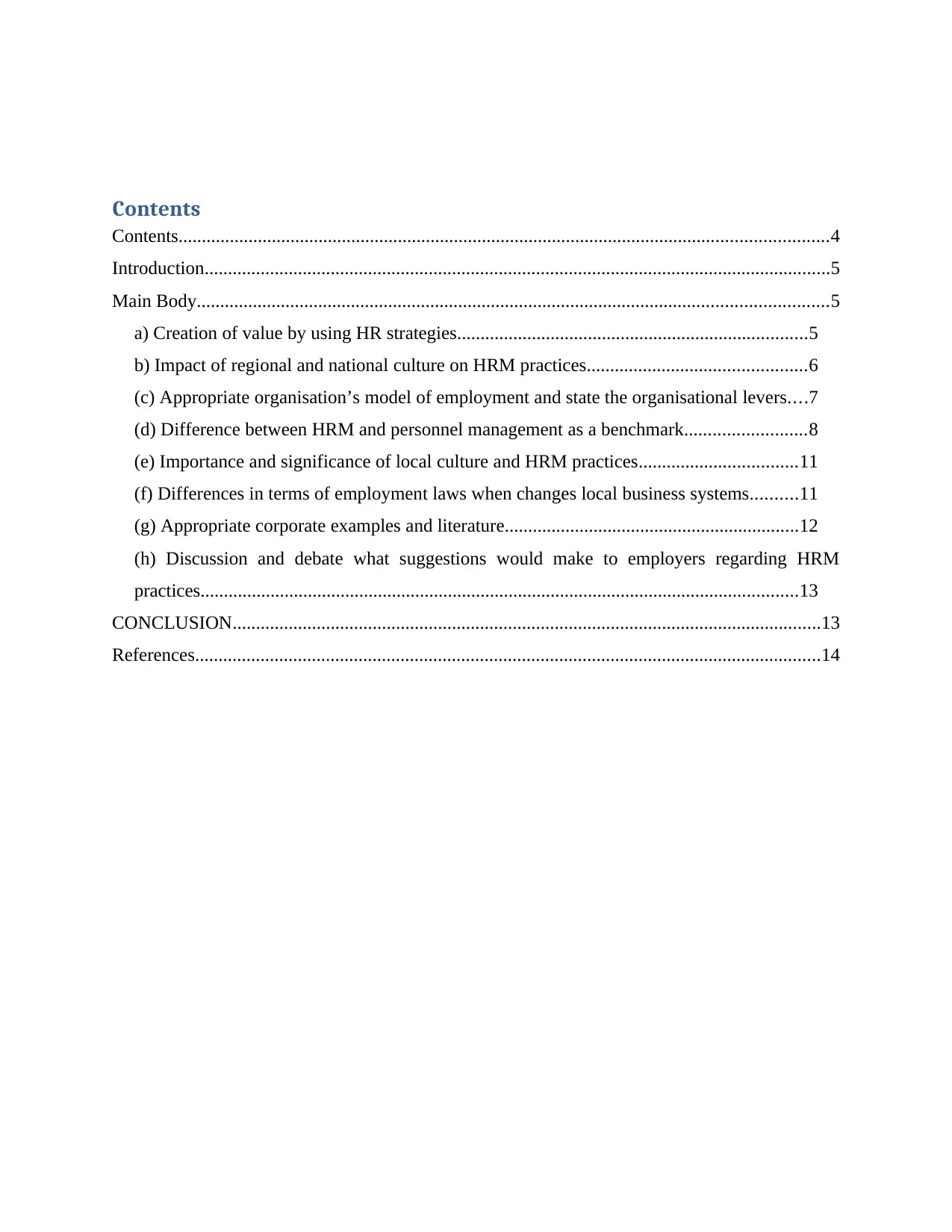
Contents
Contents...........................................................................................................................................4
Introduction......................................................................................................................................5
Main Body.......................................................................................................................................5
a) Creation of value by using HR strategies...........................................................................5
b) Impact of regional and national culture on HRM practices...............................................6
(c) Appropriate organisation’s model of employment and state the organisational levers....7
(d) Difference between HRM and personnel management as a benchmark..........................8
(e) Importance and significance of local culture and HRM practices..................................11
(f) Differences in terms of employment laws when changes local business systems..........11
(g) Appropriate corporate examples and literature...............................................................12
(h) Discussion and debate what suggestions would make to employers regarding HRM
practices................................................................................................................................13
CONCLUSION..............................................................................................................................13
References......................................................................................................................................14
Contents...........................................................................................................................................4
Introduction......................................................................................................................................5
Main Body.......................................................................................................................................5
a) Creation of value by using HR strategies...........................................................................5
b) Impact of regional and national culture on HRM practices...............................................6
(c) Appropriate organisation’s model of employment and state the organisational levers....7
(d) Difference between HRM and personnel management as a benchmark..........................8
(e) Importance and significance of local culture and HRM practices..................................11
(f) Differences in terms of employment laws when changes local business systems..........11
(g) Appropriate corporate examples and literature...............................................................12
(h) Discussion and debate what suggestions would make to employers regarding HRM
practices................................................................................................................................13
CONCLUSION..............................................................................................................................13
References......................................................................................................................................14
⊘ This is a preview!⊘
Do you want full access?
Subscribe today to unlock all pages.

Trusted by 1+ million students worldwide

Paraphrase This Document
Need a fresh take? Get an instant paraphrase of this document with our AI Paraphraser
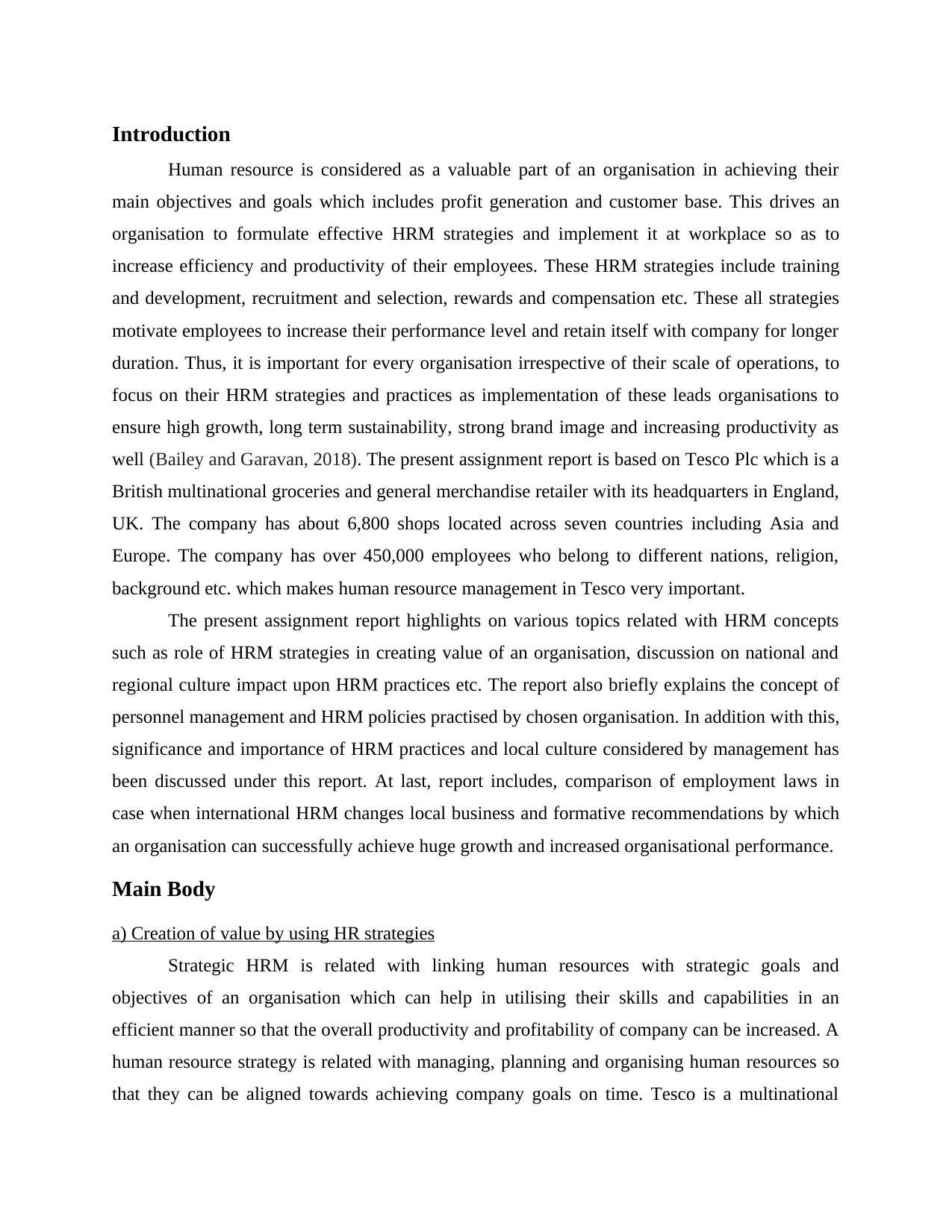
Introduction
Human resource is considered as a valuable part of an organisation in achieving their
main objectives and goals which includes profit generation and customer base. This drives an
organisation to formulate effective HRM strategies and implement it at workplace so as to
increase efficiency and productivity of their employees. These HRM strategies include training
and development, recruitment and selection, rewards and compensation etc. These all strategies
motivate employees to increase their performance level and retain itself with company for longer
duration. Thus, it is important for every organisation irrespective of their scale of operations, to
focus on their HRM strategies and practices as implementation of these leads organisations to
ensure high growth, long term sustainability, strong brand image and increasing productivity as
well (Bailey and Garavan, 2018). The present assignment report is based on Tesco Plc which is a
British multinational groceries and general merchandise retailer with its headquarters in England,
UK. The company has about 6,800 shops located across seven countries including Asia and
Europe. The company has over 450,000 employees who belong to different nations, religion,
background etc. which makes human resource management in Tesco very important.
The present assignment report highlights on various topics related with HRM concepts
such as role of HRM strategies in creating value of an organisation, discussion on national and
regional culture impact upon HRM practices etc. The report also briefly explains the concept of
personnel management and HRM policies practised by chosen organisation. In addition with this,
significance and importance of HRM practices and local culture considered by management has
been discussed under this report. At last, report includes, comparison of employment laws in
case when international HRM changes local business and formative recommendations by which
an organisation can successfully achieve huge growth and increased organisational performance.
Main Body
a) Creation of value by using HR strategies
Strategic HRM is related with linking human resources with strategic goals and
objectives of an organisation which can help in utilising their skills and capabilities in an
efficient manner so that the overall productivity and profitability of company can be increased. A
human resource strategy is related with managing, planning and organising human resources so
that they can be aligned towards achieving company goals on time. Tesco is a multinational
Human resource is considered as a valuable part of an organisation in achieving their
main objectives and goals which includes profit generation and customer base. This drives an
organisation to formulate effective HRM strategies and implement it at workplace so as to
increase efficiency and productivity of their employees. These HRM strategies include training
and development, recruitment and selection, rewards and compensation etc. These all strategies
motivate employees to increase their performance level and retain itself with company for longer
duration. Thus, it is important for every organisation irrespective of their scale of operations, to
focus on their HRM strategies and practices as implementation of these leads organisations to
ensure high growth, long term sustainability, strong brand image and increasing productivity as
well (Bailey and Garavan, 2018). The present assignment report is based on Tesco Plc which is a
British multinational groceries and general merchandise retailer with its headquarters in England,
UK. The company has about 6,800 shops located across seven countries including Asia and
Europe. The company has over 450,000 employees who belong to different nations, religion,
background etc. which makes human resource management in Tesco very important.
The present assignment report highlights on various topics related with HRM concepts
such as role of HRM strategies in creating value of an organisation, discussion on national and
regional culture impact upon HRM practices etc. The report also briefly explains the concept of
personnel management and HRM policies practised by chosen organisation. In addition with this,
significance and importance of HRM practices and local culture considered by management has
been discussed under this report. At last, report includes, comparison of employment laws in
case when international HRM changes local business and formative recommendations by which
an organisation can successfully achieve huge growth and increased organisational performance.
Main Body
a) Creation of value by using HR strategies
Strategic HRM is related with linking human resources with strategic goals and
objectives of an organisation which can help in utilising their skills and capabilities in an
efficient manner so that the overall productivity and profitability of company can be increased. A
human resource strategy is related with managing, planning and organising human resources so
that they can be aligned towards achieving company goals on time. Tesco is a multinational
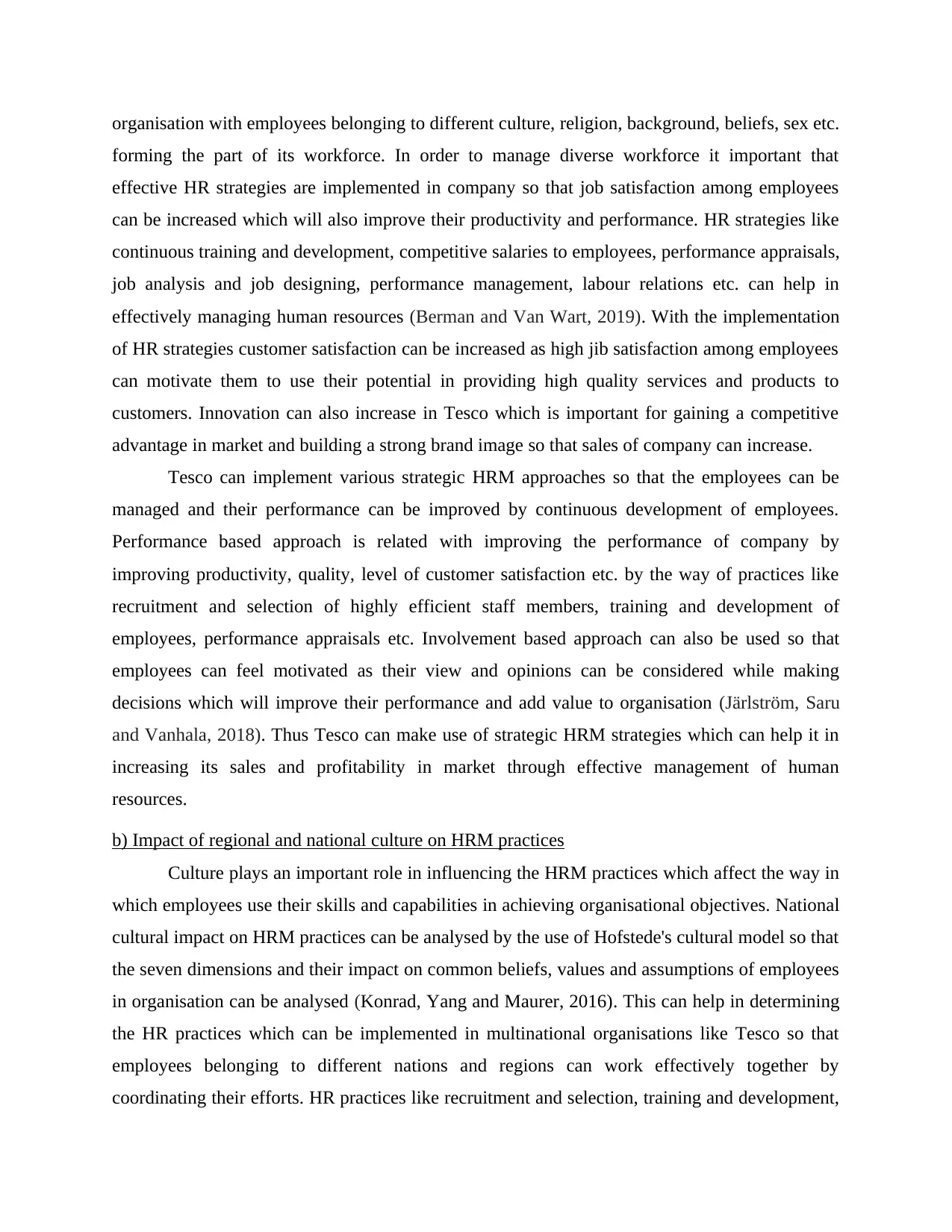
organisation with employees belonging to different culture, religion, background, beliefs, sex etc.
forming the part of its workforce. In order to manage diverse workforce it important that
effective HR strategies are implemented in company so that job satisfaction among employees
can be increased which will also improve their productivity and performance. HR strategies like
continuous training and development, competitive salaries to employees, performance appraisals,
job analysis and job designing, performance management, labour relations etc. can help in
effectively managing human resources (Berman and Van Wart, 2019). With the implementation
of HR strategies customer satisfaction can be increased as high jib satisfaction among employees
can motivate them to use their potential in providing high quality services and products to
customers. Innovation can also increase in Tesco which is important for gaining a competitive
advantage in market and building a strong brand image so that sales of company can increase.
Tesco can implement various strategic HRM approaches so that the employees can be
managed and their performance can be improved by continuous development of employees.
Performance based approach is related with improving the performance of company by
improving productivity, quality, level of customer satisfaction etc. by the way of practices like
recruitment and selection of highly efficient staff members, training and development of
employees, performance appraisals etc. Involvement based approach can also be used so that
employees can feel motivated as their view and opinions can be considered while making
decisions which will improve their performance and add value to organisation (Järlström, Saru
and Vanhala, 2018). Thus Tesco can make use of strategic HRM strategies which can help it in
increasing its sales and profitability in market through effective management of human
resources.
b) Impact of regional and national culture on HRM practices
Culture plays an important role in influencing the HRM practices which affect the way in
which employees use their skills and capabilities in achieving organisational objectives. National
cultural impact on HRM practices can be analysed by the use of Hofstede's cultural model so that
the seven dimensions and their impact on common beliefs, values and assumptions of employees
in organisation can be analysed (Konrad, Yang and Maurer, 2016). This can help in determining
the HR practices which can be implemented in multinational organisations like Tesco so that
employees belonging to different nations and regions can work effectively together by
coordinating their efforts. HR practices like recruitment and selection, training and development,
forming the part of its workforce. In order to manage diverse workforce it important that
effective HR strategies are implemented in company so that job satisfaction among employees
can be increased which will also improve their productivity and performance. HR strategies like
continuous training and development, competitive salaries to employees, performance appraisals,
job analysis and job designing, performance management, labour relations etc. can help in
effectively managing human resources (Berman and Van Wart, 2019). With the implementation
of HR strategies customer satisfaction can be increased as high jib satisfaction among employees
can motivate them to use their potential in providing high quality services and products to
customers. Innovation can also increase in Tesco which is important for gaining a competitive
advantage in market and building a strong brand image so that sales of company can increase.
Tesco can implement various strategic HRM approaches so that the employees can be
managed and their performance can be improved by continuous development of employees.
Performance based approach is related with improving the performance of company by
improving productivity, quality, level of customer satisfaction etc. by the way of practices like
recruitment and selection of highly efficient staff members, training and development of
employees, performance appraisals etc. Involvement based approach can also be used so that
employees can feel motivated as their view and opinions can be considered while making
decisions which will improve their performance and add value to organisation (Järlström, Saru
and Vanhala, 2018). Thus Tesco can make use of strategic HRM strategies which can help it in
increasing its sales and profitability in market through effective management of human
resources.
b) Impact of regional and national culture on HRM practices
Culture plays an important role in influencing the HRM practices which affect the way in
which employees use their skills and capabilities in achieving organisational objectives. National
cultural impact on HRM practices can be analysed by the use of Hofstede's cultural model so that
the seven dimensions and their impact on common beliefs, values and assumptions of employees
in organisation can be analysed (Konrad, Yang and Maurer, 2016). This can help in determining
the HR practices which can be implemented in multinational organisations like Tesco so that
employees belonging to different nations and regions can work effectively together by
coordinating their efforts. HR practices like recruitment and selection, training and development,
⊘ This is a preview!⊘
Do you want full access?
Subscribe today to unlock all pages.

Trusted by 1+ million students worldwide
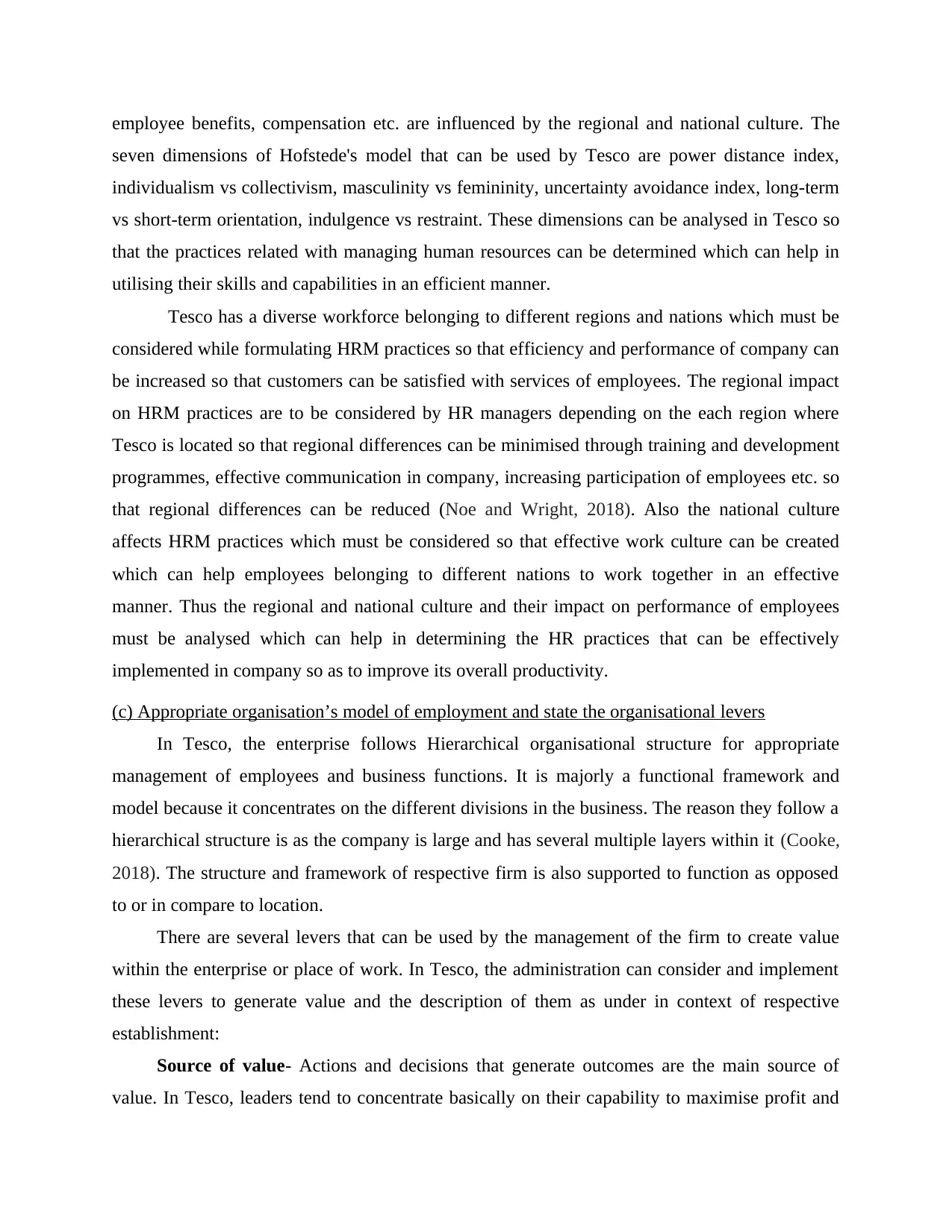
employee benefits, compensation etc. are influenced by the regional and national culture. The
seven dimensions of Hofstede's model that can be used by Tesco are power distance index,
individualism vs collectivism, masculinity vs femininity, uncertainty avoidance index, long-term
vs short-term orientation, indulgence vs restraint. These dimensions can be analysed in Tesco so
that the practices related with managing human resources can be determined which can help in
utilising their skills and capabilities in an efficient manner.
Tesco has a diverse workforce belonging to different regions and nations which must be
considered while formulating HRM practices so that efficiency and performance of company can
be increased so that customers can be satisfied with services of employees. The regional impact
on HRM practices are to be considered by HR managers depending on the each region where
Tesco is located so that regional differences can be minimised through training and development
programmes, effective communication in company, increasing participation of employees etc. so
that regional differences can be reduced (Noe and Wright, 2018). Also the national culture
affects HRM practices which must be considered so that effective work culture can be created
which can help employees belonging to different nations to work together in an effective
manner. Thus the regional and national culture and their impact on performance of employees
must be analysed which can help in determining the HR practices that can be effectively
implemented in company so as to improve its overall productivity.
(c) Appropriate organisation’s model of employment and state the organisational levers
In Tesco, the enterprise follows Hierarchical organisational structure for appropriate
management of employees and business functions. It is majorly a functional framework and
model because it concentrates on the different divisions in the business. The reason they follow a
hierarchical structure is as the company is large and has several multiple layers within it (Cooke,
2018). The structure and framework of respective firm is also supported to function as opposed
to or in compare to location.
There are several levers that can be used by the management of the firm to create value
within the enterprise or place of work. In Tesco, the administration can consider and implement
these levers to generate value and the description of them as under in context of respective
establishment:
Source of value- Actions and decisions that generate outcomes are the main source of
value. In Tesco, leaders tend to concentrate basically on their capability to maximise profit and
seven dimensions of Hofstede's model that can be used by Tesco are power distance index,
individualism vs collectivism, masculinity vs femininity, uncertainty avoidance index, long-term
vs short-term orientation, indulgence vs restraint. These dimensions can be analysed in Tesco so
that the practices related with managing human resources can be determined which can help in
utilising their skills and capabilities in an efficient manner.
Tesco has a diverse workforce belonging to different regions and nations which must be
considered while formulating HRM practices so that efficiency and performance of company can
be increased so that customers can be satisfied with services of employees. The regional impact
on HRM practices are to be considered by HR managers depending on the each region where
Tesco is located so that regional differences can be minimised through training and development
programmes, effective communication in company, increasing participation of employees etc. so
that regional differences can be reduced (Noe and Wright, 2018). Also the national culture
affects HRM practices which must be considered so that effective work culture can be created
which can help employees belonging to different nations to work together in an effective
manner. Thus the regional and national culture and their impact on performance of employees
must be analysed which can help in determining the HR practices that can be effectively
implemented in company so as to improve its overall productivity.
(c) Appropriate organisation’s model of employment and state the organisational levers
In Tesco, the enterprise follows Hierarchical organisational structure for appropriate
management of employees and business functions. It is majorly a functional framework and
model because it concentrates on the different divisions in the business. The reason they follow a
hierarchical structure is as the company is large and has several multiple layers within it (Cooke,
2018). The structure and framework of respective firm is also supported to function as opposed
to or in compare to location.
There are several levers that can be used by the management of the firm to create value
within the enterprise or place of work. In Tesco, the administration can consider and implement
these levers to generate value and the description of them as under in context of respective
establishment:
Source of value- Actions and decisions that generate outcomes are the main source of
value. In Tesco, leaders tend to concentrate basically on their capability to maximise profit and
Paraphrase This Document
Need a fresh take? Get an instant paraphrase of this document with our AI Paraphraser
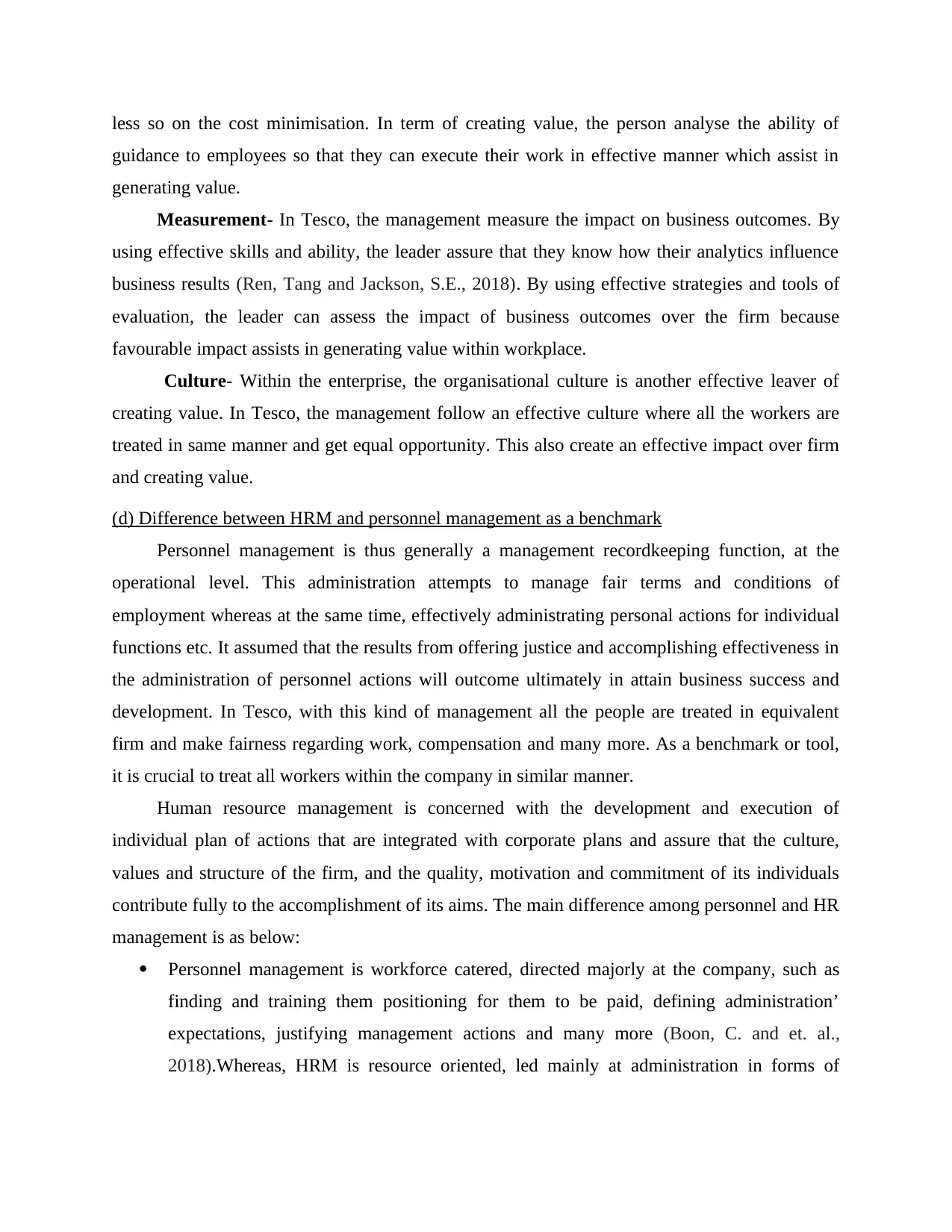
less so on the cost minimisation. In term of creating value, the person analyse the ability of
guidance to employees so that they can execute their work in effective manner which assist in
generating value.
Measurement- In Tesco, the management measure the impact on business outcomes. By
using effective skills and ability, the leader assure that they know how their analytics influence
business results (Ren, Tang and Jackson, S.E., 2018). By using effective strategies and tools of
evaluation, the leader can assess the impact of business outcomes over the firm because
favourable impact assists in generating value within workplace.
Culture- Within the enterprise, the organisational culture is another effective leaver of
creating value. In Tesco, the management follow an effective culture where all the workers are
treated in same manner and get equal opportunity. This also create an effective impact over firm
and creating value.
(d) Difference between HRM and personnel management as a benchmark
Personnel management is thus generally a management recordkeeping function, at the
operational level. This administration attempts to manage fair terms and conditions of
employment whereas at the same time, effectively administrating personal actions for individual
functions etc. It assumed that the results from offering justice and accomplishing effectiveness in
the administration of personnel actions will outcome ultimately in attain business success and
development. In Tesco, with this kind of management all the people are treated in equivalent
firm and make fairness regarding work, compensation and many more. As a benchmark or tool,
it is crucial to treat all workers within the company in similar manner.
Human resource management is concerned with the development and execution of
individual plan of actions that are integrated with corporate plans and assure that the culture,
values and structure of the firm, and the quality, motivation and commitment of its individuals
contribute fully to the accomplishment of its aims. The main difference among personnel and HR
management is as below:
Personnel management is workforce catered, directed majorly at the company, such as
finding and training them positioning for them to be paid, defining administration’
expectations, justifying management actions and many more (Boon, C. and et. al.,
2018).Whereas, HRM is resource oriented, led mainly at administration in forms of
guidance to employees so that they can execute their work in effective manner which assist in
generating value.
Measurement- In Tesco, the management measure the impact on business outcomes. By
using effective skills and ability, the leader assure that they know how their analytics influence
business results (Ren, Tang and Jackson, S.E., 2018). By using effective strategies and tools of
evaluation, the leader can assess the impact of business outcomes over the firm because
favourable impact assists in generating value within workplace.
Culture- Within the enterprise, the organisational culture is another effective leaver of
creating value. In Tesco, the management follow an effective culture where all the workers are
treated in same manner and get equal opportunity. This also create an effective impact over firm
and creating value.
(d) Difference between HRM and personnel management as a benchmark
Personnel management is thus generally a management recordkeeping function, at the
operational level. This administration attempts to manage fair terms and conditions of
employment whereas at the same time, effectively administrating personal actions for individual
functions etc. It assumed that the results from offering justice and accomplishing effectiveness in
the administration of personnel actions will outcome ultimately in attain business success and
development. In Tesco, with this kind of management all the people are treated in equivalent
firm and make fairness regarding work, compensation and many more. As a benchmark or tool,
it is crucial to treat all workers within the company in similar manner.
Human resource management is concerned with the development and execution of
individual plan of actions that are integrated with corporate plans and assure that the culture,
values and structure of the firm, and the quality, motivation and commitment of its individuals
contribute fully to the accomplishment of its aims. The main difference among personnel and HR
management is as below:
Personnel management is workforce catered, directed majorly at the company, such as
finding and training them positioning for them to be paid, defining administration’
expectations, justifying management actions and many more (Boon, C. and et. al.,
2018).Whereas, HRM is resource oriented, led mainly at administration in forms of
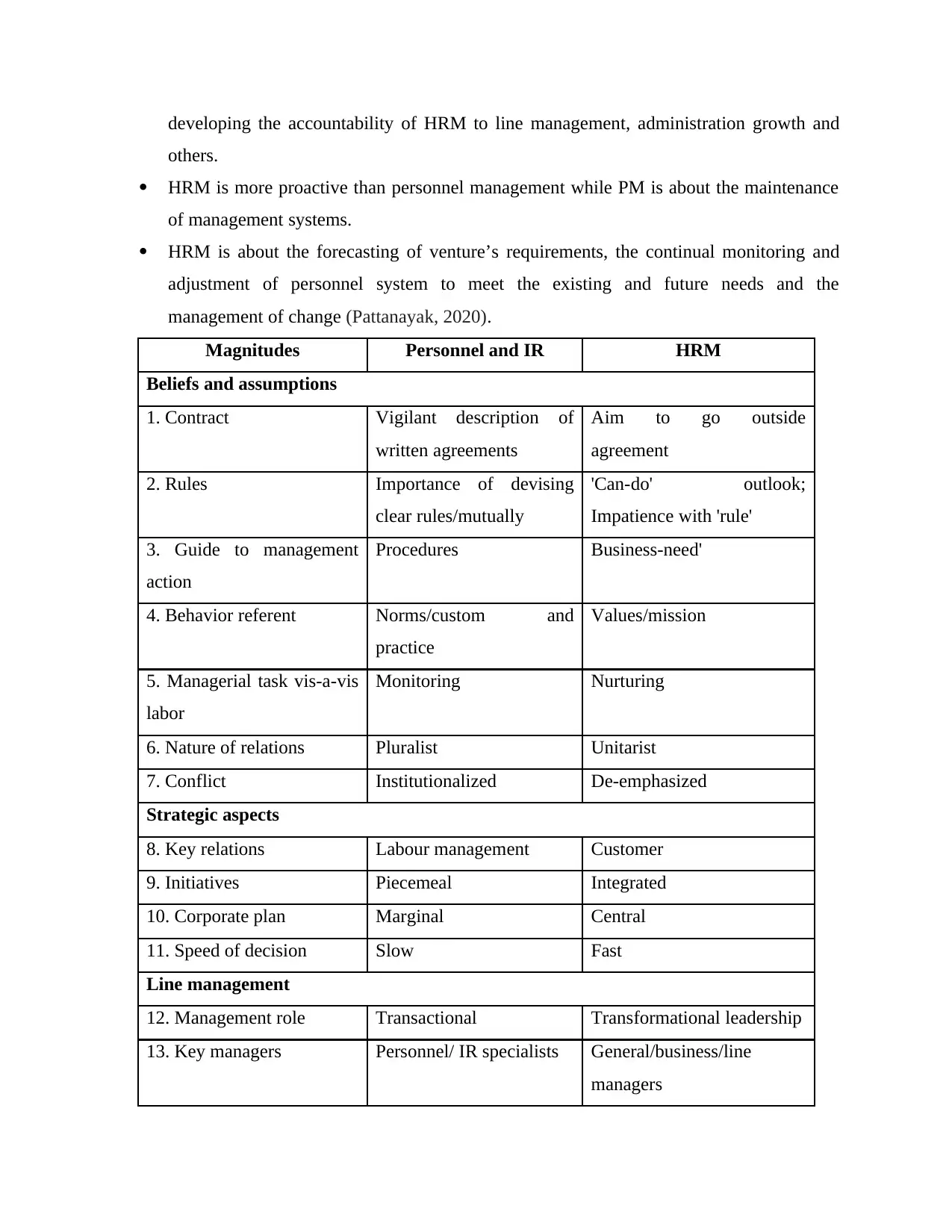
developing the accountability of HRM to line management, administration growth and
others.
HRM is more proactive than personnel management while PM is about the maintenance
of management systems.
HRM is about the forecasting of venture’s requirements, the continual monitoring and
adjustment of personnel system to meet the existing and future needs and the
management of change (Pattanayak, 2020).
Magnitudes Personnel and IR HRM
Beliefs and assumptions
1. Contract Vigilant description of
written agreements
Aim to go outside
agreement
2. Rules Importance of devising
clear rules/mutually
'Can-do' outlook;
Impatience with 'rule'
3. Guide to management
action
Procedures Business-need'
4. Behavior referent Norms/custom and
practice
Values/mission
5. Managerial task vis-a-vis
labor
Monitoring Nurturing
6. Nature of relations Pluralist Unitarist
7. Conflict Institutionalized De-emphasized
Strategic aspects
8. Key relations Labour management Customer
9. Initiatives Piecemeal Integrated
10. Corporate plan Marginal Central
11. Speed of decision Slow Fast
Line management
12. Management role Transactional Transformational leadership
13. Key managers Personnel/ IR specialists General/business/line
managers
others.
HRM is more proactive than personnel management while PM is about the maintenance
of management systems.
HRM is about the forecasting of venture’s requirements, the continual monitoring and
adjustment of personnel system to meet the existing and future needs and the
management of change (Pattanayak, 2020).
Magnitudes Personnel and IR HRM
Beliefs and assumptions
1. Contract Vigilant description of
written agreements
Aim to go outside
agreement
2. Rules Importance of devising
clear rules/mutually
'Can-do' outlook;
Impatience with 'rule'
3. Guide to management
action
Procedures Business-need'
4. Behavior referent Norms/custom and
practice
Values/mission
5. Managerial task vis-a-vis
labor
Monitoring Nurturing
6. Nature of relations Pluralist Unitarist
7. Conflict Institutionalized De-emphasized
Strategic aspects
8. Key relations Labour management Customer
9. Initiatives Piecemeal Integrated
10. Corporate plan Marginal Central
11. Speed of decision Slow Fast
Line management
12. Management role Transactional Transformational leadership
13. Key managers Personnel/ IR specialists General/business/line
managers
⊘ This is a preview!⊘
Do you want full access?
Subscribe today to unlock all pages.

Trusted by 1+ million students worldwide
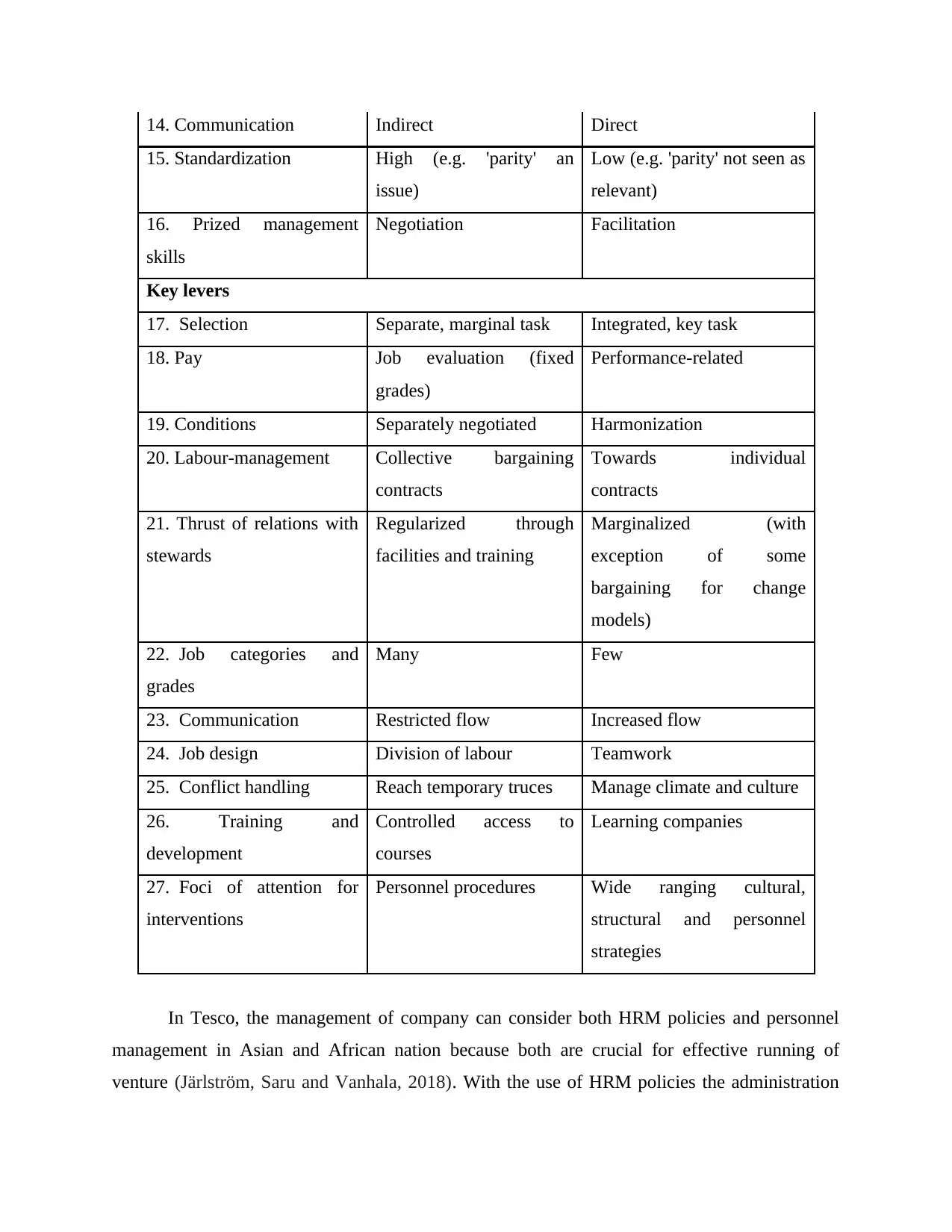
14. Communication Indirect Direct
15. Standardization High (e.g. 'parity' an
issue)
Low (e.g. 'parity' not seen as
relevant)
16. Prized management
skills
Negotiation Facilitation
Key levers
17. Selection Separate, marginal task Integrated, key task
18. Pay Job evaluation (fixed
grades)
Performance-related
19. Conditions Separately negotiated Harmonization
20. Labour-management Collective bargaining
contracts
Towards individual
contracts
21. Thrust of relations with
stewards
Regularized through
facilities and training
Marginalized (with
exception of some
bargaining for change
models)
22. Job categories and
grades
Many Few
23. Communication Restricted flow Increased flow
24. Job design Division of labour Teamwork
25. Conflict handling Reach temporary truces Manage climate and culture
26. Training and
development
Controlled access to
courses
Learning companies
27. Foci of attention for
interventions
Personnel procedures Wide ranging cultural,
structural and personnel
strategies
In Tesco, the management of company can consider both HRM policies and personnel
management in Asian and African nation because both are crucial for effective running of
venture (Järlström, Saru and Vanhala, 2018). With the use of HRM policies the administration
15. Standardization High (e.g. 'parity' an
issue)
Low (e.g. 'parity' not seen as
relevant)
16. Prized management
skills
Negotiation Facilitation
Key levers
17. Selection Separate, marginal task Integrated, key task
18. Pay Job evaluation (fixed
grades)
Performance-related
19. Conditions Separately negotiated Harmonization
20. Labour-management Collective bargaining
contracts
Towards individual
contracts
21. Thrust of relations with
stewards
Regularized through
facilities and training
Marginalized (with
exception of some
bargaining for change
models)
22. Job categories and
grades
Many Few
23. Communication Restricted flow Increased flow
24. Job design Division of labour Teamwork
25. Conflict handling Reach temporary truces Manage climate and culture
26. Training and
development
Controlled access to
courses
Learning companies
27. Foci of attention for
interventions
Personnel procedures Wide ranging cultural,
structural and personnel
strategies
In Tesco, the management of company can consider both HRM policies and personnel
management in Asian and African nation because both are crucial for effective running of
venture (Järlström, Saru and Vanhala, 2018). With the use of HRM policies the administration
Paraphrase This Document
Need a fresh take? Get an instant paraphrase of this document with our AI Paraphraser
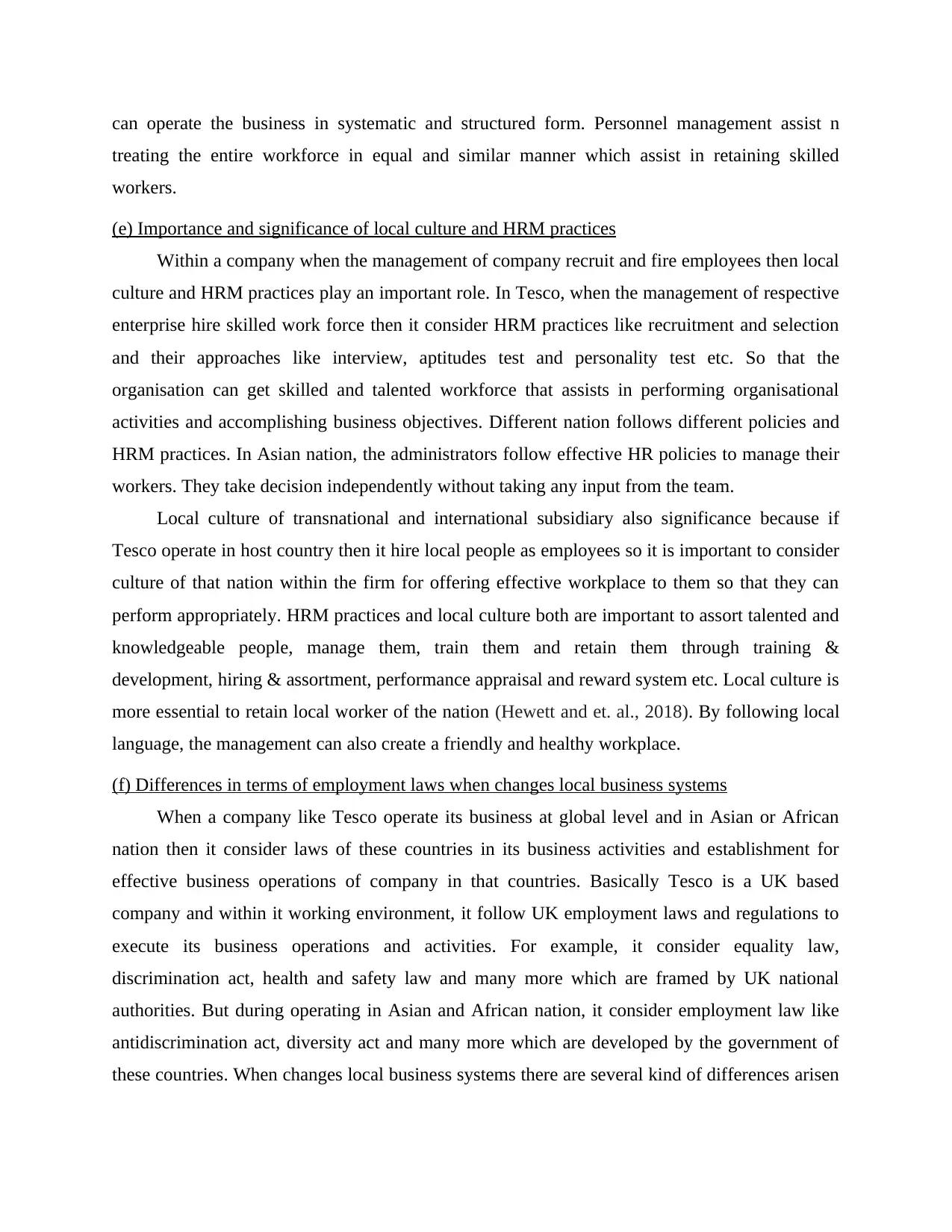
can operate the business in systematic and structured form. Personnel management assist n
treating the entire workforce in equal and similar manner which assist in retaining skilled
workers.
(e) Importance and significance of local culture and HRM practices
Within a company when the management of company recruit and fire employees then local
culture and HRM practices play an important role. In Tesco, when the management of respective
enterprise hire skilled work force then it consider HRM practices like recruitment and selection
and their approaches like interview, aptitudes test and personality test etc. So that the
organisation can get skilled and talented workforce that assists in performing organisational
activities and accomplishing business objectives. Different nation follows different policies and
HRM practices. In Asian nation, the administrators follow effective HR policies to manage their
workers. They take decision independently without taking any input from the team.
Local culture of transnational and international subsidiary also significance because if
Tesco operate in host country then it hire local people as employees so it is important to consider
culture of that nation within the firm for offering effective workplace to them so that they can
perform appropriately. HRM practices and local culture both are important to assort talented and
knowledgeable people, manage them, train them and retain them through training &
development, hiring & assortment, performance appraisal and reward system etc. Local culture is
more essential to retain local worker of the nation (Hewett and et. al., 2018). By following local
language, the management can also create a friendly and healthy workplace.
(f) Differences in terms of employment laws when changes local business systems
When a company like Tesco operate its business at global level and in Asian or African
nation then it consider laws of these countries in its business activities and establishment for
effective business operations of company in that countries. Basically Tesco is a UK based
company and within it working environment, it follow UK employment laws and regulations to
execute its business operations and activities. For example, it consider equality law,
discrimination act, health and safety law and many more which are framed by UK national
authorities. But during operating in Asian and African nation, it consider employment law like
antidiscrimination act, diversity act and many more which are developed by the government of
these countries. When changes local business systems there are several kind of differences arisen
treating the entire workforce in equal and similar manner which assist in retaining skilled
workers.
(e) Importance and significance of local culture and HRM practices
Within a company when the management of company recruit and fire employees then local
culture and HRM practices play an important role. In Tesco, when the management of respective
enterprise hire skilled work force then it consider HRM practices like recruitment and selection
and their approaches like interview, aptitudes test and personality test etc. So that the
organisation can get skilled and talented workforce that assists in performing organisational
activities and accomplishing business objectives. Different nation follows different policies and
HRM practices. In Asian nation, the administrators follow effective HR policies to manage their
workers. They take decision independently without taking any input from the team.
Local culture of transnational and international subsidiary also significance because if
Tesco operate in host country then it hire local people as employees so it is important to consider
culture of that nation within the firm for offering effective workplace to them so that they can
perform appropriately. HRM practices and local culture both are important to assort talented and
knowledgeable people, manage them, train them and retain them through training &
development, hiring & assortment, performance appraisal and reward system etc. Local culture is
more essential to retain local worker of the nation (Hewett and et. al., 2018). By following local
language, the management can also create a friendly and healthy workplace.
(f) Differences in terms of employment laws when changes local business systems
When a company like Tesco operate its business at global level and in Asian or African
nation then it consider laws of these countries in its business activities and establishment for
effective business operations of company in that countries. Basically Tesco is a UK based
company and within it working environment, it follow UK employment laws and regulations to
execute its business operations and activities. For example, it consider equality law,
discrimination act, health and safety law and many more which are framed by UK national
authorities. But during operating in Asian and African nation, it consider employment law like
antidiscrimination act, diversity act and many more which are developed by the government of
these countries. When changes local business systems there are several kind of differences arisen
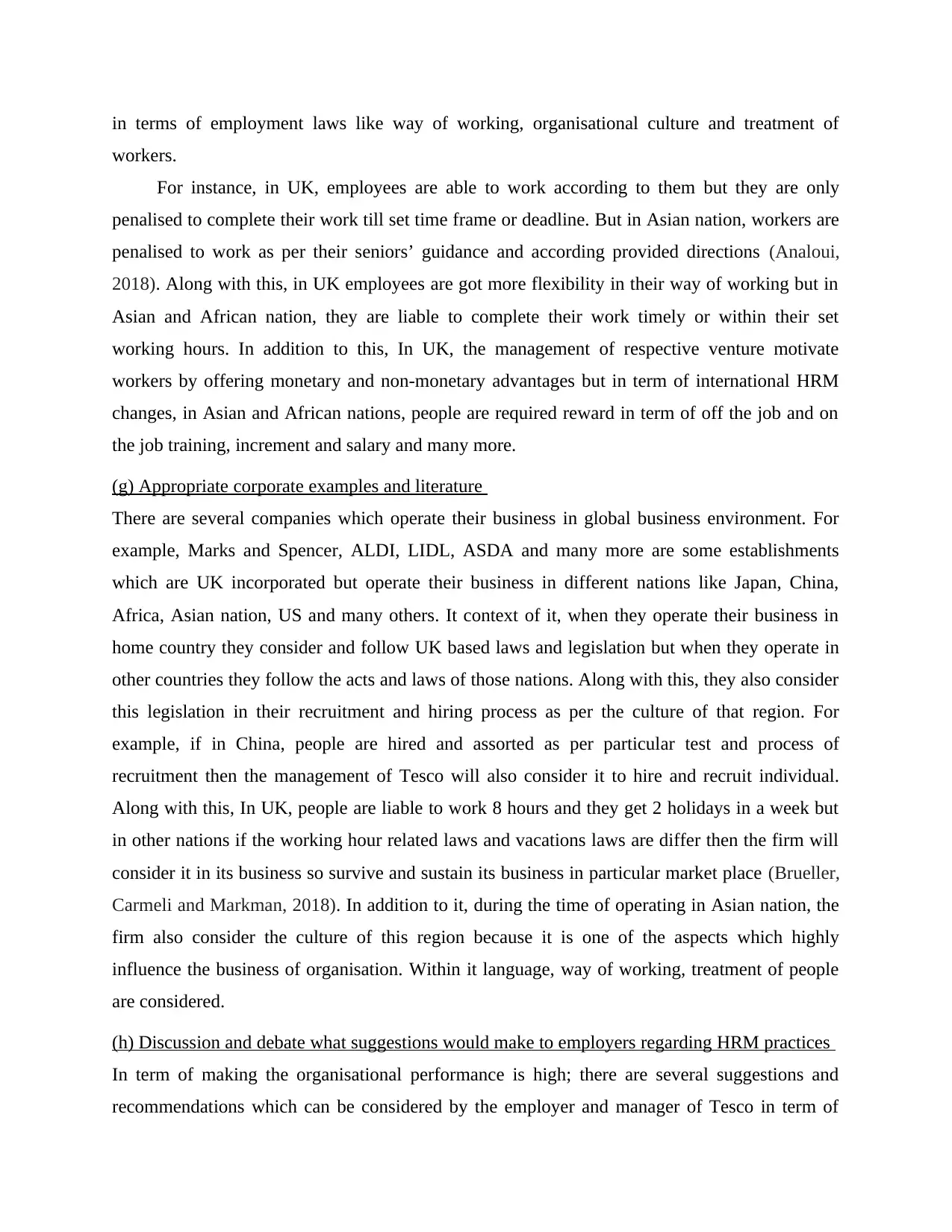
in terms of employment laws like way of working, organisational culture and treatment of
workers.
For instance, in UK, employees are able to work according to them but they are only
penalised to complete their work till set time frame or deadline. But in Asian nation, workers are
penalised to work as per their seniors’ guidance and according provided directions (Analoui,
2018). Along with this, in UK employees are got more flexibility in their way of working but in
Asian and African nation, they are liable to complete their work timely or within their set
working hours. In addition to this, In UK, the management of respective venture motivate
workers by offering monetary and non-monetary advantages but in term of international HRM
changes, in Asian and African nations, people are required reward in term of off the job and on
the job training, increment and salary and many more.
(g) Appropriate corporate examples and literature
There are several companies which operate their business in global business environment. For
example, Marks and Spencer, ALDI, LIDL, ASDA and many more are some establishments
which are UK incorporated but operate their business in different nations like Japan, China,
Africa, Asian nation, US and many others. It context of it, when they operate their business in
home country they consider and follow UK based laws and legislation but when they operate in
other countries they follow the acts and laws of those nations. Along with this, they also consider
this legislation in their recruitment and hiring process as per the culture of that region. For
example, if in China, people are hired and assorted as per particular test and process of
recruitment then the management of Tesco will also consider it to hire and recruit individual.
Along with this, In UK, people are liable to work 8 hours and they get 2 holidays in a week but
in other nations if the working hour related laws and vacations laws are differ then the firm will
consider it in its business so survive and sustain its business in particular market place (Brueller,
Carmeli and Markman, 2018). In addition to it, during the time of operating in Asian nation, the
firm also consider the culture of this region because it is one of the aspects which highly
influence the business of organisation. Within it language, way of working, treatment of people
are considered.
(h) Discussion and debate what suggestions would make to employers regarding HRM practices
In term of making the organisational performance is high; there are several suggestions and
recommendations which can be considered by the employer and manager of Tesco in term of
workers.
For instance, in UK, employees are able to work according to them but they are only
penalised to complete their work till set time frame or deadline. But in Asian nation, workers are
penalised to work as per their seniors’ guidance and according provided directions (Analoui,
2018). Along with this, in UK employees are got more flexibility in their way of working but in
Asian and African nation, they are liable to complete their work timely or within their set
working hours. In addition to this, In UK, the management of respective venture motivate
workers by offering monetary and non-monetary advantages but in term of international HRM
changes, in Asian and African nations, people are required reward in term of off the job and on
the job training, increment and salary and many more.
(g) Appropriate corporate examples and literature
There are several companies which operate their business in global business environment. For
example, Marks and Spencer, ALDI, LIDL, ASDA and many more are some establishments
which are UK incorporated but operate their business in different nations like Japan, China,
Africa, Asian nation, US and many others. It context of it, when they operate their business in
home country they consider and follow UK based laws and legislation but when they operate in
other countries they follow the acts and laws of those nations. Along with this, they also consider
this legislation in their recruitment and hiring process as per the culture of that region. For
example, if in China, people are hired and assorted as per particular test and process of
recruitment then the management of Tesco will also consider it to hire and recruit individual.
Along with this, In UK, people are liable to work 8 hours and they get 2 holidays in a week but
in other nations if the working hour related laws and vacations laws are differ then the firm will
consider it in its business so survive and sustain its business in particular market place (Brueller,
Carmeli and Markman, 2018). In addition to it, during the time of operating in Asian nation, the
firm also consider the culture of this region because it is one of the aspects which highly
influence the business of organisation. Within it language, way of working, treatment of people
are considered.
(h) Discussion and debate what suggestions would make to employers regarding HRM practices
In term of making the organisational performance is high; there are several suggestions and
recommendations which can be considered by the employer and manager of Tesco in term of
⊘ This is a preview!⊘
Do you want full access?
Subscribe today to unlock all pages.

Trusted by 1+ million students worldwide
1 out of 15
Related Documents
Your All-in-One AI-Powered Toolkit for Academic Success.
+13062052269
info@desklib.com
Available 24*7 on WhatsApp / Email
![[object Object]](/_next/static/media/star-bottom.7253800d.svg)
Unlock your academic potential
Copyright © 2020–2025 A2Z Services. All Rights Reserved. Developed and managed by ZUCOL.




